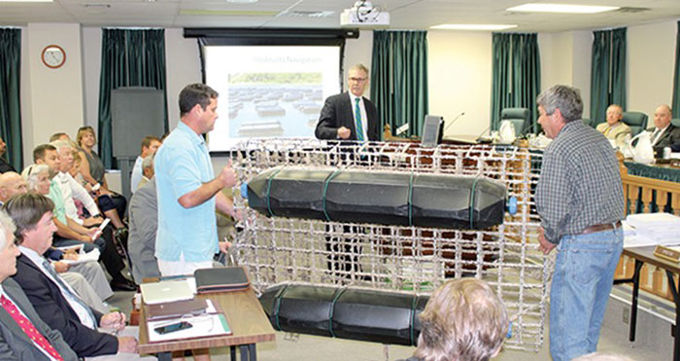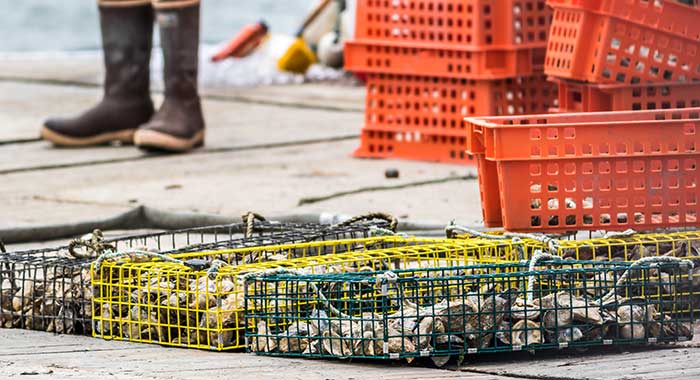
VA Riparian & Waterfront Property Rights at February 2019 VMRC Meeting
“VMRC decisions have direct and immediate consequences affecting the riparian property rights of Virginia's waterfront property owners. The VMRC makes these decisions at monthly meetings which are open to public. We attend the monthly VMRC meetings to represent our clients or as observers, and provide our readers a summary of the important cases.”
The Virginia Marine Resources Commission (VMRC) is the state agency that manages Virginia’s marine resources. The VMRC regulates the fisheries and shellfish industries and issues permits for encroachments over state-owned submerged lands. It also manages the Virginia Wetlands Act, and the Coastal Primary Sand Dune Protection Act. VMRC decisions have direct and immediate consequences affecting the riparian property rights of Virginia's waterfront property owners. The VMRC makes these decisions at monthly meetings which are open to public. We attend the monthly VMRC meetings to represent our clients or as observers, and provide our readers a summary of the important cases.
The February meeting took place on February 26, 2019 at 9:30. This was the first meeting in the VMRC’s new facility on Old Point Comfort (a/k/a Fort Monroe). A number of the Commissioners were caught in traffic, which delayed the start of the meeting, but eventually all were present with the exception of Associate Commissioner Ballard. Only two lease permits were on the agenda, along with a wetlands and subaqueous permit by Virginia Electric and Power Company.
Virginia Electric and Power Company (JPA #18-1845)

Serg64/Shutterstock.com
VEPCO requested authorization to conduct repair work to four foundation structures on one of their transmission line support towers along the Southern Branch of the Elizabeth River in Chesapeake. The work would require increasing the footprint of the foundations, installing riprap within tidal wetlands and submerged lands, and installing a temporary cofferdam during construction.
After a brief presentation by VEPCO, the Commission voted unanimously to approve the permit.
Meadowridge/Green Hill Oyster Group (Oyster Planting Ground Application #2016-229)

Rabbitti/shutterstock.com
Meadowridge/Green Hill Oyster Group “MGHOG”) consists of a number of neighbors who live on Broad Bay, which is a tributary of the Lynnhaven River in Virginia Beach. MGHOG applied for a permit for 16 acres of bottomland that runs behind a number of their properties. One written protest was filed against the application, and the protestor appeared at the hearing to testify against the permit.
“Regarding contested oyster lease applications, the proprietary data collected by our Waterfront Property Law Team (from January 2018 to present date) shows that the Commission has disapproved 32% of the lease applications that have come before it for hearing and decision. This relatively high rate of disapproval did not bode well for MGHOG nor for the oyster lease applicant who was next on the meeting agenda.”
MGHOG retained our waterfront property law team a week before the hearing to represent before the hearing. Riparian property rights attorney Jeff Wilson represented MGHOG at the hearing. Regarding contested oyster lease applications, the proprietary data collected by our Waterfront Property Law Team (from January 2018 to present date) shows that the Commission has disapproved 32% of the lease applications that have come before it for hearing and decision. This relatively high rate of disapproval did not bode well for MGHOG nor for the oyster lease applicant who was next on the meeting agenda.
Ben Stagg presented the VMRC Staff recommendation to the Commission. He started by discussing the history of permit applications in the area. He noted that in 2015, Beach Oyster Company applied for a permit for this same general area. At least 14 of the local residents protested that permit, which led to the VMRC staff recommendation that the Commission deny the application. When Beach Oyster learned of the Staff’s recommendation, it withdrew its application from consideration.
Soon after the withdrawal, MGHOG applied for the lease. All of the waterfront properties contiguous with the lease area were owned by members of MGHOG and each property included a private pier. Due to the lack of useable space between land and the channel in the bay, MGHOG made the unusual request that the VMRC include the area under the piers in its survey and make them part of the lease.
Stagg also pointed out that the only protestor was Joanne Gregory of Beach Oyster Company, who protested for the same reasons that had been used to protest Beach Oyster’s permit application, namely that the oyster lease would result in a lessening of privacy in the surrounding community and would interfere with water usage.
Stagg stated that, because of the contentious nature of the lease, the staff recommended denying the permit, but also recommended that the Commission take the unusual step of placing a ten-year moratorium on leasing the area. Stagg suggested that, since the landowners were obviously concerned about strangers farming oysters next to their properties, the moratorium would placate them on that front. Stagg also suggested that several property owners had already requested gardening permits to grow oysters on and around their piers and the moratorium would not prevent them from getting those.
MGHOG’s counsel and several of its members testified before the Commission. It quickly became clear that the Commission was concerned that MGHOG was attempting to obtain a “spite lease,” that is, that they wished to obtain the lease not to raise oysters for commercial purposes, but to prevent others from doing so. Following the staff’s lead, several Associate Commissioners asked about the possibility of garden leases, which would allow the group members to grow oysters on their property for personal consumption. At least one Associate Commissioner expressed concern that the group members may not be able to prevent their cages from falling in the channel in the event of a bad storm or similar occurrence.
MGHOG testified that despite not having a great amount of experience raising oysters, they intended on growing oysters on the lease for commercial sale, which they could not do with garden leases. They testified that group members were already spending money on seed and cages in preparation for using the lease. There was also testimony pointing out that the MGHOG application was different from Beach Oyster’s application, in that the concerns about privacy and placement of the cages would be handled by the property owners themselves, and not an outside oyster company.
Several Associate Commissioners expressed concern about the inclusion of the property owners’ pier areas in the lease. It was suggested that this would affect future owners of those properties who would find that MGHOG controlled the bottomland under their piers. MGHOG’s counsel responded that, as it was their property that was affected, any lessening of the value due to the lease would be borne by the MGHOG’s members, and that was their choice. It was also suggested that future property owners could be made part of the group and that the group would never knowingly interfere with one of their member’s property if that member objected.
This brought some questioning from Commissioner Bowman about the MGHOG itself and whether it even had standing to request a permit. He asked Mr. Stagg whether the permit should even have been considered, and Mr. Stagg said it was the staff’s belief that MGHOG had standing under their reading of the opinions of the Attorney General. Commissioner Bowman then asked the Commission’s counsel, Kelci Block, for an opinion. Ms. Block referred to Virginia Code § 28.2-604, which states, “Application for assignment of general oyster-planting ground may be made by (i) any resident of the Commonwealth, (ii) any county, municipality, or political subdivision of the Commonwealth, or (iii) any firm, or corporation chartered under the laws of this Commonwealth for the purpose of oyster culture and the oyster business provided that at least sixty percent of the stock of any such corporation is wholly owned by residents of the Commonwealth.” Ms. Block stated that she did not believe MGHOG qualified under the statute, since they were not “a resident” or a firm or corporation chartered in Virginia.
Under questioning, MGHOG members testified that they intended to set up formal rules and perhaps even incorporate, but Commissioner Bowman noted that the Commission had to consider who was actually requesting the lease.
Gregory, the lone protestor, briefly spoke as well, reiterating the issues in her protest letter.
The Commission then discussed the matter, and generally mentioned the concerns already expressed during the testimony about the effect the lease would have on the contiguous properties, the concern with the lack of oyster-growing experience among the members of MGHOG, and the fact that they likely did not have standing.
The Commission voted unanimously to accept the staff recommendation and deny the permit. Mr. Stagg then asked the Commission if it was going to consider the moratorium, and a motion was made to institute a moratorium on leasing that area of Broad Bay. After brief discussion about how a moratorium would work, the Commission voted unanimously to approve the ten-year moratorium.
Marshall G. Weisner (Oyster Planting Ground Application #2017-176)

Rabbitti/shutterstock.com
This application was another unique situation. On December 5, 2017, Mr. Weisner requested authorization to lease approximately 20 acres of oyster planting grounds within a cove tributary of the James River in Newport News. What made this application unusual is that the lease acreage was on the Joint Base Langley-Eustis, Fort Eustis location. Goose Island, which juts into the James River, has a thin spit of land that stretches back toward the mainland and creates a natural cove. Mr. Weisner was seeking to lease land within that cove.
Mr. Stagg again presented on behalf of the Staff and after describing the lease area, stated that the application was being protested by both the Joint Base Langley-Eustis Civil Engineer Division and Security Forces unit. Mr. Stagg said that his office heard from the Virginia Department of Health – Division of Shellfish Safety, who stated that they had never gone into the cove to test the water safety because it was inside the base. The agency told Mr. Stagg that for that reason, they had concerns about the safety of the water in the cove.
Mr. Stagg stated that the Civil Engineering Division had several concerns, including (1) whether oysters could survive in the area with so little tidal movement and soft bottom; (2) that the only entrance was a narrow gap that likely was inaccessible at low tide; (3) that there could be potential conflicts with military war craft training in the area; (4) that there was a private duck blind owner in the cove who may experience interference; (5) that base personnel and their families who fish the area may experience interference; and (6) potential adverse impact on waterfowl and bird wading, which would also impact local birdwatchers.
Mr. Stagg stated that the Security Forces Unit was concerned that Mr. Weisner had not received specific authorization from the Base agencies and that the area was currently under review to be classified as a restricted area by Ft. Eustis due to its location next to a port and the fact that it will be a training area in the near future. The Security Forces Unit also noted that, while Mr. Weisner is a Department of Defense employee who works on the base, the location was a particular security concern due to ease of access.
Mr. Stagg stated that, for the reasons presented, the Staff could not recommend granting the application. He continued that, unless Mr. Weisner could get explicit approval from the proper authorities on the base, the Staff believed the lease was not in the public interest.
Mr. Weisner testified that he has worked on the base for 15 years. He stated that, while he has not worked on the water before, he has friends and relatives who raise oysters. He stated that he was not interested in growing for commercial purposes but just for his own use. Mr. Weisner testified that he had researched the history of area back until the 1800s, and that the spit of land off of Goose Island does not appear on any map prior to the time the federal government purchased the property 100 years ago, so he claimed that the cove is not on Ft. Eustis property. He claims that he has a “top secret” clearance and is no security threat. Mr. Weisner also noted that there are other oyster leases in the general area.
Commissioner Bowman questioned Mr. Weisner as to whether someone other than Mr. Weisner may use the area for “nefarious purposes.” Mr. Weisner again stated that the area was not on Ft. Eustis, but Commissioner Bowman stated that the Commonwealth owns the bottomland, but it was adjacent to the Base.
After Mr. Weisner spoke, Commissioner Bowman asked if anyone wished to speak in opposition to the lease. When no one did, the Commissioner expressed concern that the agencies could not take time to appear when they were claiming that the application was a security risk. Commissioner France noted that the VMRC does not release polluted areas, and they could not determine whether the area was polluted or not. The discussion of the Commissioners centered around the water quality and the security issues. In the end, the Commissioners voted unanimously to deny the application.
Audio of the meeting is available at http://mrc.virginia.gov/calendar.shtm.
